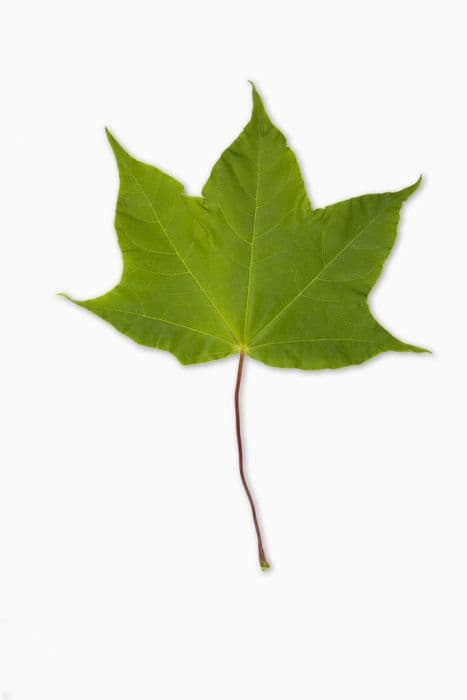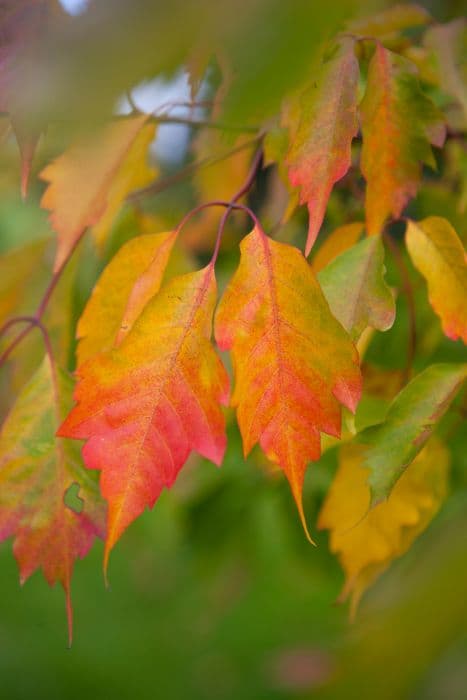Red Maple Acer rubrum

ABOUT
The plant commonly known as the red maple is a species that is admired for its striking beauty and vibrant color display. This plant is characterized by its distinctive leaves that are usually 2 to 6 inches long and borne on slender stems. The leaves are arranged oppositely on the twig and are typically comprised of 3 to 5 lobes. In terms of texture, they are smooth to the touch with a slightly paler green underside. One of the most captivating features of this plant is the seasonal color change of its foliage. In the spring and summer, the leaves are a rich green, but as the cooler months approach, they transition to brilliant shades of red, orange, or sometimes yellow, providing an exceptional display of fall color. In addition to its foliage, the red maple is often noted for its flowers and fruit. The small, yet attractive, flowers emerge early in the spring, before the leaves, and are generally red or sometimes yellow. These are followed by the fruit, which are the winged samaras typical of maples. The samaras are initially red but mature to a brown color and are carried aloft by the wind when released. The bark of the red maple is smooth and light gray when the plant is young, but as it matures, it becomes darker and breaks into long, thin strips that peel off to reveal a lighter shade beneath. The bark texture thus becomes rougher and more furrowed with age. Overall, the red maple's seasonal changes and varying textures from leaves to bark, combined with its reproductive features, make it a highly sought after and aesthetically pleasing plant for various landscapes. Its ability to adapt to a range of conditions has contributed to its popularity and widespread usage.
About this plant
 Names
NamesSynonyms
Red Maple, Swamp Maple, Water Maple, Soft Maple
Common names
Acer rubrum var. drummondii, Acer rubrum var. trilobum, Acer rubrum f. rubrum, Acer rubrum f. drummondii, Acer rubrum f. trilobum.
 Toxicity
ToxicityTo humans
Red maple is not typically considered toxic to humans. However, as with many plants, it can cause minor irritation or allergic reactions in some individuals. There are no well-documented cases of poisoning from ingesting red maple. If any part of the plant is ingested and symptoms do appear, they might include stomach upset or dermatitis from handling the leaves. It's always advised to avoid eating parts of ornamental plants due to potential unknown effects.
To pets
Red maple can be toxic to pets, particularly horses. Ingesting leaves, especially wilted or dried leaves, can cause a condition known as red maple leaf poisoning. Symptoms in horses include lethargy, dark brown urine, increased heart and respiratory rates, jaundice, and potentially death. The toxicosis is caused due to the breakdown of red blood cells, leading to acute hemolytic anemia. Immediate veterinary care is required if ingestion is suspected. While red maple is particularly harmful to horses, it is less clear the extent of its toxicity to other pets like dogs and cats, but it would be prudent to keep all pets away from the plant.
 Characteristics
CharacteristicsLife cycle
Perennials
Foliage type
Deciduous
Color of leaves
Green
Flower color
Red
Height
40-60 feet (12-18 meters)
Spread
30-40 feet (9-12 meters)
Plant type
Tree
Hardiness zones
3-9
Native area
North America
Benefits
 General Benefits
General Benefits- Ecosystem support: Provides habitat and food for wildlife including birds and small mammals.
- Landscape aesthetics: Red maple is known for its vibrant fall color, enhancing natural and urban landscapes.
- Shade and cooling: Offers shade, thereby reducing energy costs for cooling in the summer.
- Soil stabilization: Has a root system that helps to prevent erosion by stabilizing soil.
- Carbon sequestration: Captures and stores carbon dioxide, helping to mitigate climate change.
- Seasonal interest: Offers year-round visual interest with changing leaves, flowers, and seeds.
- Habitat structure: Contributes to forest stratification, providing different layers of canopy for biodiversity.
- Water management: Helps in managing stormwater runoff and improving water quality.
 Medical Properties
Medical Properties- Antioxidant: Red maple (Acer rubrum) may contain compounds with antioxidant properties.
- Astringent: The bark has historically been used for its astringent qualities.
- Antidiabetic: Some studies suggest that extracts from Acer rubrum could have potential antidiabetic effects.
- Anti-inflammatory: Constituents in the leaves or bark could possess anti-inflammatory actions.
 Air-purifying Qualities
Air-purifying QualitiesThis plant is not specifically known for air purifying qualities.
 Other Uses
Other Uses- Acer rubrum, commonly known as Red Maple, wood can be utilized in the creation of musical instruments like violins and guitars for its aesthetic grain and good resonance.
- The sap of Red Maple can be used for making maple syrup, although it is not as sweet or preferred as that from the Sugar Maple.
- Red Maple is often used as a parent in hybridization efforts to improve the ornamental qualities of other maple species or varieties.
- Red Maple leaves can be collected and used as an eco-friendly dye for fabrics and garments, producing earth-toned hues.
- The Red Maple's dense canopy provides a habitat for numerous birds and mammals, serving as a key species in supporting biodiversity.
- Red Maple is used in landscape architecture for erosion control, as its root systems stabilize the soil effectively.
- The fall foliage of Red Maple is harvested and used in the craft industry for creating preserved leaf arrangements and decorations.
- Red Maple twigs and smaller branches may be gathered and employed in basket weaving and other traditional handicrafts.
- Young Red Maple trees are sometimes cultivated as bonsai, making use of their naturally attractive shape and colorful leaves.
- Red Maple can be incorporated into agroforestry systems to provide shade for understory crops that require protection from direct sunlight.
Interesting Facts
 Feng Shui
Feng ShuiThe Red Maple is not used in Feng Shui practice.
 Zodiac Sign Compitability
Zodiac Sign CompitabilityThe Red Maple is not used in astrology practice.
 Plant Symbolism
Plant Symbolism- Beauty: Acer rubrum, commonly known as the Red Maple, displays vibrant red colors that symbolize beauty and grace in nature.
- Strength: The Red Maple is a hardy species that can withstand a wide range of environmental conditions, representing strength and resilience.
- Balance: The Red Maple often grows in a symmetrical shape, symbolizing balance and equanimity.
- Change: As a tree with leaves that change color with the seasons, the Red Maple symbolizes the inevitable and beautiful nature of change.
- Peace: In some cultures, the Red Maple is a symbol of peace and tranquility, offering a calming presence.
 Water
WaterFor the Red Maple, it's essential to maintain a consistent moisture level, especially during the first few years after planting and during drought conditions. Water the tree deeply and slowly once a week, providing about 10-15 gallons of water to ensure it reaches the root zone. During the growing season, you may need to increase watering to twice a week if the weather is particularly dry or hot. Cut back on watering during the fall to help the tree harden off for winter. It is not necessary to water if the tree is established and there has been sufficient rainfall.
 Light
LightThe Red Maple thrives best in full sun to partial shade conditions, meaning it requires at least 4-6 hours of direct sunlight each day. The ideal spot for a Red Maple is an area where it can receive morning sunlight and some afternoon shade, or a location with dappled sunlight throughout the day. Avoid planting it in deep shade as this can reduce growth and the vibrancy of fall foliage.
 Temperature
TemperatureThe Red Maple is hardy and can tolerate a wide range of temperature conditions, generally surviving minimum winter temperatures down to -40°F and maximum summer temperatures well above 100°F. Ideally, Red Maples prefer temperate conditions that range between 60°F and 75°F. It is important to avoid exposing young trees to extreme temperature swings, especially in spring and fall, to prevent damage.
 Pruning
PruningPruning the Red Maple should be done to maintain its shape, to remove any dead or damaged branches, and to improve air circulation. The best time to prune is in late winter or early spring before new growth begins. Prune sparingly; removing no more than 25% of the tree's crown in one season is generally recommended. Always use clean and sharp pruning tools to make clean cuts.
 Cleaning
CleaningAs needed
 Soil
SoilRed Maple thrives in a well-draining soil mix with a slightly acidic to neutral pH of about 5.5 to 7.0. A mix of loamy soil, peat, and sand or perlite is often recommended for optimal growth and health.
 Repotting
RepottingRed Maple trees, when grown as bonsai or in containers, should be repotted every 2 to 3 years. For young trees, repotting may be necessary more frequently to accommodate rapid growth.
 Humidity & Misting
Humidity & MistingRed Maple prefers moderate humidity levels but is adaptable to a wide range of humidity conditions, making it suitable for varied outdoor climates.
 Suitable locations
Suitable locationsIndoor
Red Maples are not ideal for indoor growth.
Outdoor
Provide full sun to partial shade and regular watering for outdoor growth.
Hardiness zone
3-9 USDA
 Life cycle
Life cycleThe life cycle of the Red Maple (Acer rubrum) begins with seed dispersal, which generally takes place in spring, relying on wind to carry the samaras or "helicopter seeds" away from the parent tree. After landing in a suitable location, the seeds germinate and the seedling emerges, establishing a root system and a shoot that will become the trunk. As the sapling grows, it develops branches, leaves, and undergoes photosynthesis to produce the energy necessary for growth, reaching maturity in about 70 to 80 years. The mature Red Maple will start producing flowers that are usually red or sometimes yellow, with the tree being monoecious, having both male and female flowers, which can lead to self-pollination or cross-pollination by wind or insects. Following pollination, the flowers develop into samaras, which will eventually be dispersed, completing the reproductive cycle. The Red Maple can live for up to 150 years or more, throughout which it continues the cycle of seed production and dispersal annually.
 Propogation
PropogationPropogation time
Late winter
The most popular method of propagating the Red Maple (Acer rubrum) is by seed. The best time to collect seeds is in late spring or early summer when they mature, turning from green to a light brown color. To propagate by seed, one must first stratify the seeds to overcome dormancy, which involves storing them in moist sand or peat at a cool temperature of 34°F to 40°F (1°C to 4.5°C) for 60 to 90 days. After stratification, the seeds can be sown in either the fall or early spring in prepared beds with well-draining soil. Sowing at a depth of about 1/4 inch is adequate, and seeds should be spaced to allow for seedling growth. Seedlings usually emerge in the spring and can be transplanted into their permanent location once they have developed a strong root system.









